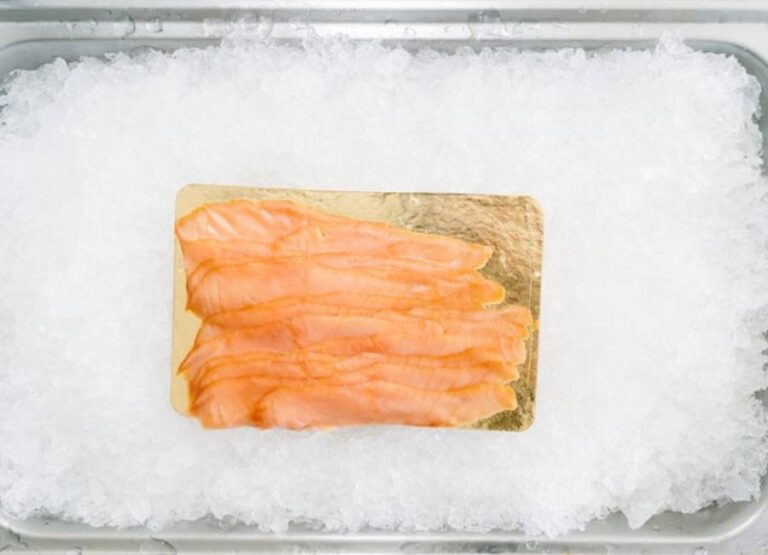Is It Safe To Eat Raw Fish [Useful Insight]
Are you a sushi lover, but hesitant to try sashimi or other raw fish dishes? You’re not alone.
Many people are wary of consuming raw seafood due to concerns about food safety. But is this fear justified?
In this article, we’ll take a closer look at the safety of eating raw fish and explore the risks and benefits of indulging in this popular culinary trend.
So sit back, relax, and get ready to learn more about the delicious world of raw fish!
Is It Safe To Eat Raw Fish
Eating raw fish can be risky as it may contain harmful bacteria, viruses, and parasites that can cause foodborne illnesses, however, if the fish has been properly handled and stored, it can be safe to eat raw.
It’s important to purchase fish from a reputable source and use safe food handling practices to reduce the risk of illness.
While the risk of eating raw fish is minimal for most healthy people, it can be serious for others.
According to the FDA, consuming raw or undercooked fish can result in foodborne illness caused by parasites or bacteria, such as Vibrio, Salmonella, or Listeria.
Regularly eating raw fish also increases the risk of parasitic infections, which can be rare but can cause serious health problems.
Additionally, not all fish are suitable for raw consumption, and selecting the right fish can be important.
To minimize risk, it is recommended to purchase sushi-grade fish or to freeze the fish at -4 °F or lower for at least 7 days to kill the parasites before consumption.
So, while it’s possible to eat raw fish safely, it’s important to take precautions and be aware of the risks involved.
Health benefits of consuming raw fish
Consuming raw fish can have several health benefits, including being a low-fat, heart-healthy source of protein.
Raw fish is also a good source of omega-3 fatty acids, which can help improve heart health and reduce inflammation in the body.
Raw seafood can also provide many crucial vitamins and minerals such as vitamin A, vitamin D, zinc, magnesium, and B12, all of which contribute to overall health and wellness.
However, it is important to make sure that the raw fish is properly sourced, handled, and stored to reduce the risk of foodborne illness.
Learn more about pregnant women eating raw tuna.
Traditional raw fish dishes and their safety measures
Traditional raw fish dishes, such as sushi and sashimi, can be delicious, but it is important to take appropriate safety measures to prevent foodborne illness.
Here are some popular raw fish dishes and some safety measures to keep in mind:
- Sushi rolls – Sushi rolls typically include cooked or raw fish, rice, and vegetables wrapped in seaweed. When ordering sushi, ensure that the restaurant is using fresh, high-quality fish and that all staff members handling the food are following proper food safety protocols.
- Sashimi – Sashimi is thinly sliced raw fish served without rice. It is important to only eat sashimi that has been properly prepared and stored at the correct temperature to prevent bacterial growth.
- Ceviche – Ceviche is a dish that typically involves “cooking” raw fish in citrus juices. While the acid from the citrus can help kill bacteria, it is still important to use fresh fish and to properly store and prepare the dish.
- Carpaccio – Carpaccio is thin slices of raw fish or seafood typically served with a dressing or sauce. As with other raw fish dishes, it is important to only eat carpaccio that has been properly prepared and stored.
- Poke – Poke is a Hawaiian dish that typically consists of diced raw fish, served on top of rice or greens with various toppings. Similar to other raw fish dishes, be sure to only eat poke made with fresh fish and follow appropriate safety measures when handling and preparing the dish.
Overall, it is important to follow basic food safety guidelines, such as properly washing your hands and separating raw and cooked foods, when preparing and consuming raw fish dishes.
If you have any concerns about the safety of a particular dish, it is best to err on the side of caution and avoid eating it.
Potential health risks associated with raw fish consumption
Raw fish consumption may pose several potential health risks which include:
- Food poisoning: Raw fish can be contaminated with harmful bacteria such as Vibrio, Salmonella, and Campylobacter, which can cause food poisoning.
- Parasitic infections: Raw fish may contain parasites such as tapeworms, nematodes, and flukes, which can cause various infections.
- Hepatitis A: Raw fish may harbor the hepatitis A virus, which can cause liver inflammation and disease.
- Norovirus: Raw fish may contain norovirus, which can cause gastroenteritis, resulting in diarrhea, nausea, and vomiting.
- Mercury poisoning: Some types of fish may contain high levels of mercury, which can be toxic in large amounts and may cause neurological problems.
- Allergic reactions: Some people may develop an allergic reaction to raw fish, leading to symptoms such as hives, swelling, and difficulty breathing.
- Histamine poisoning: Eating spoiled or improperly stored raw fish can cause histamine poisoning, resulting in symptoms such as flushing, headache, and abdominal cramps.
- High cholesterol: Raw fish such as tuna and salmon contain high levels of cholesterol, which can contribute to heart disease.
- Vitamin B12 deficiency: Raw fish consumption may impair the body’s ability to absorb vitamin B12, which can lead to anemia and nerve damage over time.
It is important to note that not all raw fish poses a health risk, but it is essential to be aware of the potential hazards and take necessary precautions when consuming it.
Learn more about types of fish to avoid when pregnant.
Precautions for eating and handling raw fish
Here are some precautions for eating and handling raw fish:
- Purchase from a reputable source: Always buy fresh fish from a trusted source.
- Store properly: Fresh fish should be stored on ice in the refrigerator or freezer immediately after purchase.
- Avoid cross-contamination: Keep raw fish away from other foods, and use separate cutting boards, utensils, and dishes for raw fish.
- Wash hands and equipment: Hands, utensils, and equipment should be washed thoroughly with hot soapy water both before and after handling raw fish.
- Freeze first: Freezing fish at -4°F or below for at least 7 days before consumption can also help kill parasites.
- Be aware of allergies: Raw fish can cause allergic reactions in some people, so it’s important to know if you or someone you’re serving has a fish allergy.
Personal considerations and alternatives to eating raw fish
When it comes to eating raw fish, there are several personal considerations to keep in mind.
Firstly, raw fish can be dangerous if it is not prepared properly, as it can contain harmful bacteria or parasites.
Secondly, individuals who are pregnant or have compromised immune systems should avoid eating raw fish altogether.
Additionally, some people may have ethical or environmental concerns about consuming fish.
If you are looking for alternatives to eating raw fish, there are several options to consider.
Cooked fish is a safe and healthy alternative that can be prepared in a variety of ways.
Plant-based protein sources, such as legumes, tofu, and tempeh, can also be used as substitutes for fish in many recipes. Other protein sources, such as chicken, beef, and pork, can be used as well.
It’s important to note that not all protein sources are created equal, and some may be more nutritious than others.
For example, fish is a rich source of omega-3 fatty acids, which are important for heart health.
If you are looking for a plant-based alternative to fish that is high in omega-3s, consider incorporating flaxseeds, chia seeds, or walnuts into your diet.
Ultimately, the best alternative to eating raw fish will depend on your personal preferences and dietary needs.
It’s important to consult with a healthcare provider or registered dietitian if you have any specific concerns or questions about your diet.
FAQs
What are the risks of eating raw fish?
Eating raw or undercooked fish can pose several health risks, including food poisoning, bacterial infections, and parasitic infections. Symptoms of these illnesses can range from mild stomach upset to more serious complications, so it’s important to be aware of the risks and take proper precautions when handling and consuming raw seafood.
What types of fish are safe to eat raw?
Certain types of fish are more commonly eaten raw than others, including salmon, tuna, and mackerel. These fish are generally considered safe as long as they have been handled and prepared properly. Other types of fish, such as shellfish, are more likely to harbor harmful bacteria or parasites and should be cooked thoroughly before eating.
How can I make sure the fish I’m eating is safe?
To reduce the risk of foodborne illnesses, it’s important to make sure that any raw fish you eat has been handled and prepared properly. This means buying seafood from a reliable source, storing it at the correct temperature, and cleaning and cooking it thoroughly before eating. If you’re unsure about how to prepare raw fish safely, it’s always a good idea to consult a professional chef or a food safety expert.
Can I eat sushi if I’m pregnant?
Pregnant women are advised to avoid certain types of fish that are high in mercury, a toxic metal that can harm a developing fetus. This includes large predatory fish such as sharks, swordfish, and mackerel, as well as raw shellfish. However, many types of sushi are perfectly safe for pregnant women to eat, as long as they stick to low-mercury fish such as salmon and shrimp.
What are some tips for handling raw seafood safely?
When handling raw seafood, it’s important to follow some basic food safety guidelines. This includes washing your hands thoroughly before and after handling seafood, using separate knives and cutting boards for raw and cooked foods, and storing raw seafood at the correct temperature (below 40 °F). Additionally, fish should be thawed in the refrigerator rather than at room temperature to avoid bacterial growth. Overall, taking these precautions can help reduce the risk of foodborne illnesses when preparing and consuming raw fish.
Conclusion
In conclusion, eating raw fish is generally safe as long as you take the necessary precautions and choose high-quality and fresh fish.
By following some basic guidelines, such as buying from a reputable source and properly storing and preparing the fish, you can safely enjoy sushi, ceviche, and other delicious raw fish dishes.
So go ahead, indulge in some raw fish, and savor every bite!


![Can Pregnant Women Eat Raw Tuna [Answered]](https://foodcreeks.com/wp-content/uploads/2023/02/Can-Pregnant-Women-Eat-Raw-Tuna-768x555.jpg)
![Can You Have Ahi Tuna When Pregnant [Insight]](https://foodcreeks.com/wp-content/uploads/2023/02/Can-You-Have-ahi-Tuna-When-Pregnant-768x555.jpg)


![Can Pregnant Women Eat Fried Fish [Answered]](https://foodcreeks.com/wp-content/uploads/2023/02/Can-Pregnant-Women-Eat-Fried-Fish-768x555.jpg)
![Can Pregnant Women Eat Canned Tuna [Answered]](https://foodcreeks.com/wp-content/uploads/2023/03/Can-Pregnant-Women-Eat-Canned-Tuna-768x555.jpg)